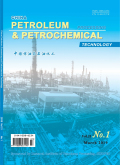- 钛学术文献服务平台 \
- 学术期刊 \
- 工业技术期刊 \
- 石油与天然气工业期刊 \
- 中国炼油与石油化工(英文版)期刊 \
Study on Property of Salicylaldehyde Schiff Base Metal Complexes for Catalytic Oxidation of Model Sulfides
Study on Property of Salicylaldehyde Schiff Base Metal Complexes for Catalytic Oxidation of Model Sulfides
基本信息来源于合作网站,原文需代理用户跳转至来源网站获取
摘要:
Seven kinds of Schiff base metal complexes (C1—C7) were synthesized by the reaction of substituted salicylaldehyde Schiff base with cobalt nitrate, nickel nitrate, and copper nitrate, respectively. The oxygen carrying performance, and the catalytic property of complexes for the oxidation of model sulfides 1-hexanethiol, dibutyl sulfide, and 2-methylthiophene along with their influencing factors were explored, while the oxidized products of the model sulfides were also analyzed and characterized. The results show that the catalytic oxidation property of the complexes is determined by their oxygen carrying performance and solubility in n-octane. The oxygen carrying performance of the complexes is mainly affected by the central ion species, the electronic effects, and the spatial effects of the substituents as well as the degree of conjugation. More specifically, the oxygen carrying performance can be improved by enhancing the oxygenation capacity of the central metal ions, increasing the electron donating ability of the ligand substituent, and diminishing the steric hindrance as well as extending the conjugated chain. Complexes C7 were found to be with high oxygen carrying capacity and high solubility in n-octane, which shows the best catalytic oxidation property, and the oxidation conversion rates for 1-hexylthiol, dibutyl sulfide, and 2-methylthiophene are 74.2%, 65.1%, and 22.7%, respectively. Upon using the oxidation catalyst of Schiff base metal complexes, three sulfides can be oxidized by oxygen to form sulfones and sulfoxides. 1-Hexanethiol and dibutyl sulfide will continue to be oxidized to form sulfates and sulfites.

推荐文章
An experimental study on metal precipitation driven by fluid mixing: implications for genesis of car
Metal precipitation
Fluid mixing
Sulfur species
MVT lead–zinc ore deposits
Carbonate-hosted
lead–zinc deposits
A study of groundwater irrigation water quality in south-central Bangladesh: a geo-statistical model
Semivariogram
Ordinary kriging model
Salinity
Irrigation water quality index
GIS
Hydrochemistry
Microaerobic iron oxidation and carbon assimilation and associated microbial community in paddy soil
Paddy soil
Microaerobic Fe(Ⅱ)-oxidation
CO2 assimilation
SIP
内容分析
关键词云
关键词热度
相关文献总数
(/次)
(/年)
文献信息
| 篇名 | Study on Property of Salicylaldehyde Schiff Base Metal Complexes for Catalytic Oxidation of Model Sulfides | ||
| 来源期刊 | 中国炼油与石油化工(英文版) | 学科 | |
| 关键词 | |||
| 年,卷(期) | 2021,(1) | 所属期刊栏目 | Catalyst Research |
| 研究方向 | 页码范围 | 58-66 | |
| 页数 | 9页 | 分类号 | |
| 字数 | 语种 | 英文 | |
| DOI | |||
五维指标
引文网络
引文网络
二级参考文献 (27)
共引文献 (15)
参考文献 (11)
节点文献
引证文献 (0)
同被引文献 (0)
二级引证文献 (0)
1973(1)
- 参考文献(1)
- 二级参考文献(0)
1974(1)
- 参考文献(1)
- 二级参考文献(0)
1999(2)
- 参考文献(1)
- 二级参考文献(1)
2000(3)
- 参考文献(0)
- 二级参考文献(3)
2001(2)
- 参考文献(0)
- 二级参考文献(2)
2003(2)
- 参考文献(0)
- 二级参考文献(2)
2004(1)
- 参考文献(0)
- 二级参考文献(1)
2005(1)
- 参考文献(0)
- 二级参考文献(1)
2006(2)
- 参考文献(1)
- 二级参考文献(1)
2007(2)
- 参考文献(0)
- 二级参考文献(2)
2008(3)
- 参考文献(1)
- 二级参考文献(2)
2009(8)
- 参考文献(0)
- 二级参考文献(8)
2010(3)
- 参考文献(1)
- 二级参考文献(2)
2011(1)
- 参考文献(0)
- 二级参考文献(1)
2013(3)
- 参考文献(2)
- 二级参考文献(1)
2014(2)
- 参考文献(2)
- 二级参考文献(0)
2015(1)
- 参考文献(1)
- 二级参考文献(0)
2021(0)
- 参考文献(0)
- 二级参考文献(0)
- 引证文献(0)
- 二级引证文献(0)
引文网络交叉学科
相关学者/机构
期刊影响力
中国炼油与石油化工(英文版)
主办单位:
中国石化集团石油化工科学研究院
出版周期:
季刊
ISSN:
1008-6234
CN:
11-4012/TE
开本:
大16开
出版地:
北京海淀学院路18号
邮发代号:
创刊时间:
1999
语种:
eng
出版文献量(篇)
1608
总下载数(次)
0
总被引数(次)
1651
期刊文献
相关文献
推荐文献
- 期刊分类
- 期刊(年)
- 期刊(期)
- 期刊推荐
一般工业技术
交通运输
军事科技
冶金工业
动力工程
化学工业
原子能技术
大学学报
建筑科学
无线电电子学与电信技术
机械与仪表工业
水利工程
环境科学与安全科学
电工技术
石油与天然气工业
矿业工程
自动化技术与计算机技术
航空航天
轻工业与手工业
金属学与金属工艺
中国炼油与石油化工(英文版)2022
中国炼油与石油化工(英文版)2021
中国炼油与石油化工(英文版)2020
中国炼油与石油化工(英文版)2019
中国炼油与石油化工(英文版)2018
中国炼油与石油化工(英文版)2017
中国炼油与石油化工(英文版)2016
中国炼油与石油化工(英文版)2015
中国炼油与石油化工(英文版)2014
中国炼油与石油化工(英文版)2013
中国炼油与石油化工(英文版)2012
中国炼油与石油化工(英文版)2011
中国炼油与石油化工(英文版)2010
中国炼油与石油化工(英文版)2009
中国炼油与石油化工(英文版)2008
中国炼油与石油化工(英文版)2007
中国炼油与石油化工(英文版)2006
中国炼油与石油化工(英文版)2005
中国炼油与石油化工(英文版)2004
中国炼油与石油化工(英文版)2003
中国炼油与石油化工(英文版)2002
中国炼油与石油化工(英文版)2001
中国炼油与石油化工(英文版)2000

 免费查重
免费查重










